 Last additions Last additions |

Seibu Ikebukuro Line train at Chichibu StationApr 28, 2007
|
|

Outside the main entrance is this area full of food and souvenir stalls.Apr 28, 2007
|
|

PosterApr 28, 2007
|
|

Apr 28, 2007
|
|

Yae-zakura cherry blossoms and moss pink.Apr 28, 2007
|
|

Apr 28, 2007
|
|

Yae-zakura cherry blossoms combine well with moss pink.Apr 28, 2007
|
|

Apr 28, 2007
|
|

Apr 28, 2007
|
|

Apr 28, 2007
|
|

Apr 28, 2007
|
|

The shadowy areas bloom much later.Apr 28, 2007
|
|

Apr 28, 2007
|
|

Scarlet Flame before full bloom.Apr 28, 2007
|
|

Circular rainbowApr 28, 2007
|
|

Apr 28, 2007
|
|

Apr 28, 2007
|
|

Apr 28, 2007
|
|

Apr 28, 2007
|
|

Apr 28, 2007
|
|

Apr 28, 2007
|
|

Apr 28, 2007
|
|

Apr 28, 2007
|
|

Apr 28, 2007
|
|

Apr 28, 2007
|
|

The park allows dogs, but they bark and ruin the peace. They should ban dogs from the park.Apr 28, 2007
|
|

Corner workApr 28, 2007
|
|

The flower patterns don't look like anything.Apr 28, 2007
|
|

YApr 28, 2007
|
|

Apr 28, 2007
|
|

Apr 28, 2007
|
|

Are your eyes getting tired of seeing this mountain and flowers?Apr 28, 2007
|
|

Tulip and moss pinkApr 28, 2007
|
|

YApr 28, 2007
|
|

TricotApr 28, 2007
|
|

Apr 28, 2007
|
|

Apr 28, 2007
|
|

Apr 28, 2007
|
|

Apr 28, 2007
|
|

Apr 28, 2007
|
|

Apr 28, 2007
|
|

Apr 28, 2007
|
|

Apr 28, 2007
|
|

Apr 28, 2007
|
|

Apr 28, 2007
|
|

Apr 28, 2007
|
|

I found an almost infinite number of image combinations of the flowers and mountain.Apr 28, 2007
|
|

Apr 28, 2007
|
|

The combination of Mt. Bukosan and the flowers are almost unlimited. Chichibu, Saitama. 武甲山Apr 28, 2007
|
|

Apr 28, 2007
|
|

Benches offer visitors a rest.Apr 28, 2007
|
|

Mt. Bukosan and moss pink. 武甲山Apr 28, 2007
|
|

Apr 28, 2007
|
|

Apr 28, 2007
|
|

Apr 28, 2007
|
|

Apr 28, 2007
|
|

Apr 28, 2007
|
|

Apr 28, 2007
|
|

Apr 28, 2007
|
|

武甲山Apr 28, 2007
|
|

武甲山Apr 28, 2007
|
|

Apr 28, 2007
|
|

Apr 28, 2007
|
|

Mt. Bukosan is being slowly eaten away by cement companies. 武甲山Apr 28, 2007
|
|

The top of one slope provides a grand view of the flower carpet and Mt. Bukosan, one symbol of Chichibu. 武甲山Apr 28, 2007
|
|

Apr 28, 2007
|
|

Apr 28, 2007
|
|

Tama-no-Nagare. Means "Flow of Tama." Tama is a river. 多摩の流れApr 28, 2007
|
|

Tama-no-Nagare look light pink from afar.Apr 28, 2007
|
|

Tama-no-Nagare have a pink stripe on each petal. 多摩の流れApr 28, 2007
|
|

Apr 28, 2007
|
|

Scarlet Flame スカーレットフレームApr 28, 2007
|
|

Scarlet FlameApr 28, 2007
|
|

Scarlet Flame are red. スカーレットフレームApr 28, 2007
|
|

Apr 28, 2007
|
|

Oakington BlueApr 28, 2007
|
|

Oakington Blue オーキントンブルーApr 28, 2007
|
|

Oakington Blue are bluish flowers. オーキントンブルーApr 28, 2007
|
|

McDaniel's Cushion マックダニエルクッションApr 28, 2007
|
|

McDaniel's CushionApr 28, 2007
|
|

Apr 28, 2007
|
|

McDaniel's Cushion are dark pink flowers. マックダニエルクッションApr 28, 2007
|
|

Apr 28, 2007
|
|

Little DotApr 28, 2007
|
|

Little Dot. リットルドットApr 28, 2007
|
|

Little Dot are white flowers with a yellow dot at the center. リットルドットApr 28, 2007
|
|

Autumn Rose. Moss pink flowers have five petals with notches, looking like miniature cherry blossoms. The flowers are small. オータムローズApr 28, 2007
|
|

Eight varieties of moss pink are planted. This is Autumn Rose. オータムローズApr 28, 2007
|
|

Moss pink is therefore commonly called "shiba-zakura" which can be translated as "grassy cherry blossoms" or "lawn cherry blossoms."Apr 28, 2007
|
|

Apr 28, 2007
|
|

These photos were taken in late April 2007. (Copyright year in the images are mistaken.)Apr 28, 2007
|
|

It is not yet full bloom. A few patches of green.Apr 28, 2007
|
|

On sunny days, great for taking pictures.Apr 28, 2007
|
|

The map tells you how to walk to the park, but better to just follow the signs.Apr 28, 2007
|
|

Entrance to Hitsujiyama Park. Show your ticket or buy it at the booth nearby.Apr 28, 2007
|
|

Quite spectacular when the flowers are in full bloom.Apr 28, 2007
|
|

If you go early in the morning, there are fewer people.Apr 28, 2007
|
|

Seibu Ikebukuro Line train with shibazakura design.Apr 28, 2007
|
|

Seibu Ikebukuro Line train station entrance at Ikebukuro, Tokyo. It takes about 90 min. from Ikebukuro to Yokoze Station via Tokkyu express train. Cheaper trains take 2 hours.Apr 28, 2007
|
|

You can buy a park entry ticket (300 yen) at a booth in front of Yokoze Station. Maps also available. Underpass at Yokoze Station.Apr 28, 2007
|
|

Seibu Ikebukuro Line Yokoze Station. Get off here for an easy walk to Hitsujiyama Park where the Shibazakura moss pink hill is. A tourist info office is on the left. 西武池袋線横瀬駅Apr 28, 2007
|
|
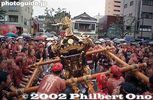
Dramatic display of mikoshi maneuversApr 24, 2007
|
|

Apr 24, 2007
|
|

Apr 24, 2007
|
|

Being at the shrine's torii entrance is a great place to watch the mikoshi.Apr 24, 2007
|
|

Apr 24, 2007
|
|

The shrine's happi coat has a design for the character "Hachi" (for Hachimangu) consisting of two pigeons. Pigeons are regarded as the messengers of the deity worshipped at Hachimangu shrines in Japan.Apr 24, 2007
|
|

Apr 24, 2007
|
|

Apr 24, 2007
|
|

One after another, the mikoshi arrives in front of the shrine.Apr 24, 2007
|
|
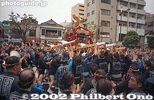
Apr 24, 2007
|
|
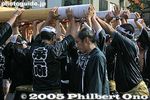
Apr 24, 2007
|
|
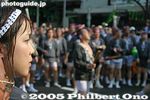
Apr 24, 2007
|
|

Apr 24, 2007
|
|

The portable shrine gets a final mid-air toss while passing by Tomioka Hachimangu Shrine. This mid-air toss of the portable shrine is called "mai-age" or tossing up.Apr 24, 2007
|
|

Crowd at the shrine entrance.Apr 24, 2007
|
|

And give their last show.Apr 24, 2007
|
|

Tossing a mikoshi.Apr 24, 2007
|
|
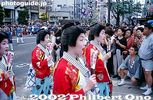
Apr 24, 2007
|
|
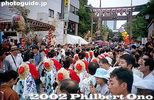
The tekomai geisha enter Tomioka Hachimangu Shrine.Apr 24, 2007
|
|
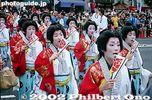
The tekomai geisha enter the shrine.Apr 24, 2007
|
|

As the portable shrines reach the shrine, they give one last show before returning to their parish.Apr 24, 2007
|
|
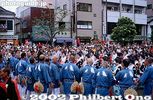
The tekomai geisha arrives at Tomioka Hachimangu Shrine.Apr 24, 2007
|
|

Hand clappingApr 24, 2007
|
|

Apr 24, 2007
|
|

Apr 24, 2007
|
|

The tekomai geisha enter the shrine.Apr 24, 2007
|
|

Large crowd watch the mikoshi parade near Tomioka Hachimangu Shrine on Eitai-dori road.Apr 24, 2007
|
|

Wet womenApr 24, 2007
|
|

Apr 24, 2007
|
|

For some reason, it's fun to see people get wet...Apr 24, 2007
|
|

Apr 24, 2007
|
|

Getting wet upside down might be an extra thrill...Apr 24, 2007
|
|

Apr 24, 2007
|
|

Apr 24, 2007
|
|

In front of the water truck. Soon to be filled with people and a portable shrine.Apr 24, 2007
|
|

The mikoshi is raised high as they all bathe in water. Taking photos like this one requires adequate water protection of your camera and lens.Apr 24, 2007
|
|

Onegaishimasu! お願いします!Apr 24, 2007
|
|
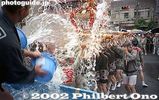
Hai, OK (ha-ha!).Apr 24, 2007
|
|

During a break, two kids get water.Apr 24, 2007
|
|

Apr 24, 2007
|
|

A large truck filled with water with people using buckets to splash water in rapid succession.Apr 24, 2007
|
|

Fukagawa Hachiman Matsuri, mizu-kakeApr 24, 2007
|
|
|

This is the final stretch and wettest part of the festival.Apr 24, 2007
|
|

Prepared for the water...Apr 24, 2007
|
|

Apr 24, 2007
|
|

View from behind the "water truck." This goes on for about 15 seconds. The truck is refilled with a fire hose. All in the name of purification.Apr 24, 2007
|
|

Apr 24, 2007
|
|

Wet faceApr 24, 2007
|
|

Crowd on Eitai-dori roadApr 24, 2007
|
|

Every time, the water hoses are at the same location.Apr 24, 2007
|
|

After crossing Eitai-bashi Bridge, the portable shrines headed for the main stretch on Eitai-dori avenue already filled with people. The wettest and most crowded part of the festival is held along this one kilometer of road between the bridge and shrine.Apr 24, 2007
|
|

A fire hose. The local fire department with a fire hose on Eitai-dori avenue.Apr 24, 2007
|
|

A portable shrine crosses Eitai-bashi Bridge.Apr 24, 2007
|
|

Water sprayApr 24, 2007
|
|

Apr 24, 2007
|
|

Another portable shrine crosses Eitai-bashi Bridge.Apr 24, 2007
|
|

The water hose is now handled by volunteers, not real firemen.Apr 24, 2007
|
|

Using a water hose is an efficient way to get people wet. But see what the big boys use..Apr 24, 2007
|
|

Tekomai geisha on Eitai-dori road, entering Koto WardApr 24, 2007
|
|

Apr 24, 2007
|
|

A portable shrine crosses Eitai-bashi Bridge.Apr 24, 2007
|
|

They sing and chant while walking slowly.Apr 24, 2007
|
|

Apr 24, 2007
|
|

Apr 24, 2007
|
|
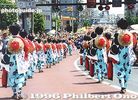
They do not get water splashed.Apr 24, 2007
|
|

They have flower hats, but I've never seen them wear it on their heads.Apr 24, 2007
|
|

Apr 24, 2007
|
|

Tekomai geisha at EitaibashiApr 24, 2007
|
|

手古舞Apr 24, 2007
|
|

Tekomai geishaApr 24, 2007
|
|
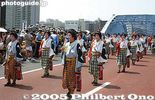
Tekomai geisha at Eitai-bashiApr 24, 2007
|
|

Crossing over Eitai-bashi Bridge. 永代橋Apr 24, 2007
|
|

Tekomai geisha cross Eitai-bashi Bridge to enter Koto Ward along Eitai-dori.Apr 24, 2007
|
|

Phoenix atop a portable shrine.Apr 24, 2007
|
|

Kiyosu-bashi Bridge over the Sumida River, Important Cultural Property 清洲橋 国の重要文化財Apr 24, 2007
|
|

Apr 24, 2007
|
|

A horde of people follow each portable shrine.Apr 24, 2007
|
|

Crossing Kiyosu-bashi BridgeApr 24, 2007
|
|

Apr 24, 2007
|
|

Apr 24, 2007
|
|

With raised arms, this is one way to carry the mikoshi.Apr 24, 2007
|
|

Apr 24, 2007
|
|

Crossing Kiyosu-bashi BridgeApr 24, 2007
|
|

Crossing Kiyosu-bashi Bridge. They chant "wasshoi wasshoi!" as they carry the mikoshi. 清洲橋Apr 24, 2007
|
|

Raising the mikoshi on Kiyosu-bashi BridgeApr 24, 2007
|
|

Crossing Kiyosu-bashi BridgeApr 24, 2007
|
|

Crossing Kiyosu-bashi Bridge over Sumida River.Apr 24, 2007
|
|

Splash you. This is a day when kids can be mean to grown-ups. This little girl kept filling up her bowl and ran around splashing some unlucky person.I hope that's her school teacher.Apr 24, 2007
|
|

Water hose at Kiyosu-bashi BridgeApr 24, 2007
|
|

Water splashing truck near Kiyosu-bashi BridgeApr 24, 2007
|
|

Apr 24, 2007
|
|

This mikoshi is being carried by all women, already soaked to the bone. They carry the mikoshi flat on their shoulders. This is called "Hira katsugi," literally "flat carrying."There are four basic methods of carrying a portable shrine. This is the most basic method where they carry it flat on their shoulders. This is called "Hira katsugi," literally "flat carrying."Apr 24, 2007
|
|

"Hey Ho, Let's Go!"Apr 24, 2007
|
|

Apr 24, 2007
|
|

Apr 24, 2007
|
|

Standard uniform of portable shrine bearers (for both men and women).The headband may be tied at the front or back of the head. It may also be tied on the head like a bonnet. There is a variety of ways of tying the headband.
The happi coat bears the name of the parish or district the person belongs to. The same name is displayed on the respective portable shrine. The shorts are white and skintight. Worn by both men and women. Also called Han-momo or Han-momohiki. The white tabi (sock-like shoe) has a rubber sole.Apr 24, 2007
|
|

Apr 24, 2007
|
|

Apr 24, 2007
|
|

The portable shrines are paraded through a route which will take them almost all day to complete, from 7:30 am to 3 pm.Apr 24, 2007
|
|

The mikoshi are splashed with water in whichever way possible. This is in the middle of summer, so it's a good way to cool off.Apr 24, 2007
|
|

People in happi coats carry the mikoshi while shouting "Wasshoi, wasshoi!"Apr 24, 2007
|
|

Each mikoshi is preceded by a row of women carrying lanterns and wands. Also see the video at YouTubeApr 24, 2007
|
|

As the mikoshi depart, there is some entertainment at the Tomioka Hachimangu Shrine.Apr 24, 2007
|
|

Apr 24, 2007
|
|

In front of the shrine, a shrine priest blesses each portable shrine as it departs to join the procession.Apr 24, 2007
|
|

Taiko drummers at Tomioka Hachimangu Shrine.Apr 24, 2007
|
|
|
|

This is early in the morning when the 54 portable shrines who had gathered in front of the shrine depart for the procession one after another.Apr 24, 2007
|
|

This troupe of 25 local women preserve a traditional art of Edo. They attend regular singing practice led by an elderly woman who was an authentic tekomai in her day.Apr 24, 2007
|
|

Omiko shrine maidens. On the previous day during the Sacred Carriage Procession, they performed sacred dances on a truck. お巫女Apr 24, 2007
|
|

In front of Tomioka Hachimangu Shrine on Eitai-dori road.Apr 24, 2007
|
|

Tekomai geisha. They existed since the Edo Period. They served as side entertainment at festivals. They only sing traditional chant-like songs called kiyari. 手古舞Apr 24, 2007
|
|

Shrine priest on horseback. The start of one of Tokyo's Big Three Festivals. These photos show the festival's climax on the last day of the festival when over 50 portable shrines are paraded along the streets amid splashing water. It is the Rengo Apr 24, 2007
|
|

Tekomai geisha. Their costume is colorful and partially masculine with trousers instead of skirts. Their right shoulder is "exposed" to show a peony flower (botan) design. They carry a red paper lantern imprinted with their names.Apr 24, 2007
|
|

Every three years (2017, 2020, 2023, 2026, etc.), the full-scale version of this festival is held in mid-Aug. The festival's last day is the climax with this procession of over 50 portable shrines. Led by this banner which reads Tomioka Hachimangu.Apr 24, 2007
|
|

Making sure that the rope is aligned and positioned correctly.Apr 23, 2007
|
|

The rope installers return to shore.Apr 23, 2007
|
|
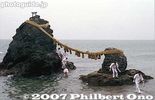
The job is finished.Apr 23, 2007
|
|
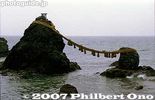
Wedded Rocks with a new rope. Japan has numerous other Wedded Rocks and stones, but this is by far the most famous.Apr 23, 2007
|
|
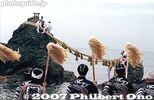
Apr 23, 2007
|
|
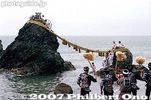
Apr 23, 2007
|
|
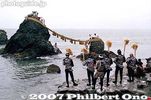
Apr 23, 2007
|
|
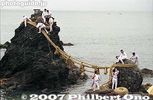
Replacing the rope for the Wedded Rocks, Mie Pref.Apr 23, 2007
|
|

Pieces of the old rope. Anyone could take home the pieces of old sacred rope if they wanted.Apr 23, 2007
|
|

Apr 23, 2007
|
|

Five ropes are being positioned and made taut.Apr 23, 2007
|
|

All the while, the cheering section chants and wave streamers.Apr 23, 2007
|
|
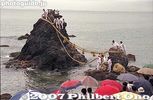
Apr 23, 2007
|
|
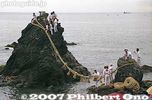
Apr 23, 2007
|
|

The second rope is installed.Apr 23, 2007
|
|

One by one, the men carefully positioned the new sacred ropes on the two Rocks. All the while, young children and young men are chanting on the shore.Apr 23, 2007
|
|

The new ropes are strung across the two rocks. A small rope tied to the end of the large rope is used to pull the large rope up the rock.Apr 23, 2007
|
|

The first rope is wound around both rocks.Apr 23, 2007
|
|
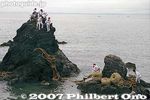
The old rope is taken away.Apr 23, 2007
|
|

Apr 23, 2007
|
|
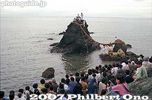
The ceremony attracts a large crowd.Apr 23, 2007
|
|

The ropes are now completely cut, breaking the bond between the two rocks.Apr 23, 2007
|
|

The shimenawa rope actually consists of five smaller ropes. They cut the ropes one by one.Apr 23, 2007
|
|
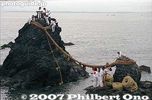
The men begin to cut off the old rope. Those sharp sickles soon made short work of the old sacred ropes which were brought ashore in small pieces.Apr 23, 2007
|
|
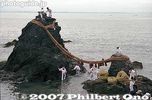
5月5日、9月5日と12月下旬には夫婦岩の大注連縄の張り替え神事が行われる。これらの写真は5月5日に撮影された。Apr 23, 2007
|
|
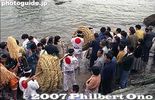
Men carry spanking-new shimenawa ropes to the rocks.Apr 23, 2007
|
|
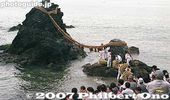
The Wedded Rocks are actually a type of torii gate for worshipping the Okitama Sacred Stone in the ocean.Apr 23, 2007
|
|

The torii on the larger rock is quite small. The sacred rope is replaced three times a year on May 5, September 5, and at the end of December.Apr 23, 2007
|
|
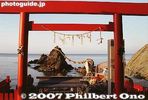
Futami Okitama Shrine does not have a main hall (Honden) like most other shrines. It worships the Okitama Sacred Stone in the ocean beyond the Wedded Rocks. 二見興玉神社Apr 23, 2007
|
|

Lantern and sunset at Futami Okitama ShrineApr 23, 2007
|
|

The shimenawa rope bonding the Wedded Rocks is replaced three times a year. May 5, when these photos were taken, is one of the days when they replace the rope. First, they gathered at the shrine at 10 am for a 30-min. prayer ceremony.Apr 23, 2007
|
|

Sunset at Futami Okitama Shrine. In the old days when traveling was a hazardous undertaking in Japan, pilgrims who traveled to worship at the Ise Grand Shrines prayed here for a safe return home.Apr 23, 2007
|
|

The frog is Sarutahiko's messenger. Frog is called "kaeru" in Japanese, which is a homonym for the another word meaning "return home." If you travel a lot, pray here for a safe return. 夫婦岩Apr 23, 2007
|
|

Meoto-Iwa Wedded Rocks off the coast of Futami-cho, Ise city, Mie Prefecture. 夫婦岩Apr 23, 2007
|
|

The shrine is dedicated to Sarutahiko and Ukano-mitama. Sarutahiko is a god which serves as a pathfinder guide. Deities for land/sea transportation safety. 二見�Apr 23, 2007
|
|
| 71466 files on 284 page(s) |
 |
 |
234 |  |
 |
|